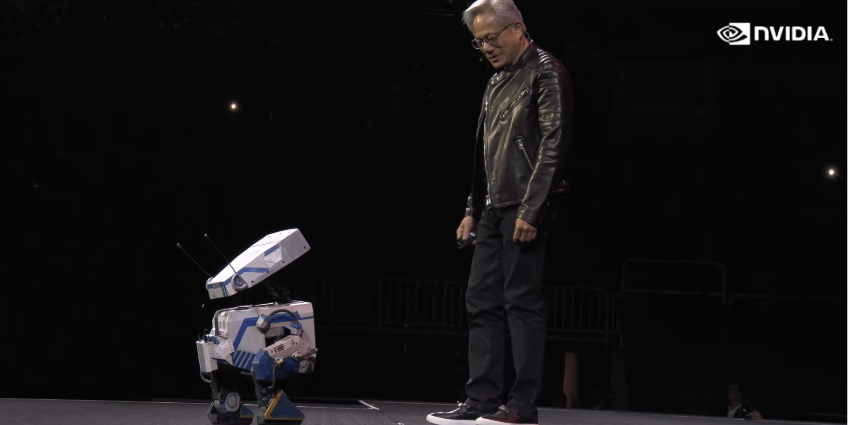At NVIDIA’s GTC 2025 conference, CEO Jensen Huang took center stage in his signature leather jacket to unveil a vision that reasserts the company’s dominance in AI hardware.
Calling the event “the Super Bowl of AI,” Huang delivered a packed two-hour keynote that demonstrated why NVIDIA remains the powerhouse driving AI innovation, despite recent market volatility.
Reclaiming the throne After Market Turbulence
The timing of GTC 2025 couldn’t be more important for NVIDIA.
Just two months ago, the company suffered its largest single-day market value loss in history, with shares plummeting 17% and erasing nearly $600 billion following DeepSeek’s AI advancements. This dramatic correction brought NVIDIA’s stock back to October 2024 levels and sent shockwaves through the tech sector.
Meanwhile, hardware competition looms.
Meta has begun testing its first custom-designed AI training chip, while OpenAI is finalizing designs for its own AI accelerator, reportedly with a $500 million budget. These developments reflect growing industry concerns about dependency on NVIDIA, which controls approximately 80% of the AI chip market.
Yet Huang’s keynote made it clear: NVIDIA isn’t ceding ground.
An Ambitious Roadmap to Maintain Dominance
NVIDIA unveiled a three-pronged approach to maintain its leadership:
- More powerful hardware
- Enhanced software capabilities
- Expanded partnerships across industries
The hardware roadmap is particularly aggressive.
Following the current Blackwell architecture, NVIDIA plans to release Blackwell Ultra in late 2025, followed by Vera Rubin in 2026 and Feynman in 2027-2028. Each generation promises substantial performance gains, with Blackwell already offering 40x the inference performance of its predecessor.
“We are a power-limited industry,” Huang acknowledged, highlighting how the NVIDIA Dynamo software stack will optimize performance. Described as “essentially the operating system of an AI factory,” Dynamo addresses the complexity of orchestrating AI workloads at scale.

Huang revealed:
[AI computation needs are] easily 100x more than we thought we needed at this time last year.
To address this demand, NVIDIA showcased extreme system configurations, including the Rubin Ultra NVL576, featuring 2.5 million parts connected to 576 GPUs.
Bridging to Physical AI
Perhaps most intriguing is NVIDIA’s push into “physical AI” – the intersection of AI and robotics. The company unveiled Isaac GROOT N1, “the world’s first open Humanoid Robot foundation model,” alongside comprehensive development tools.
“The time has come for robots,” Huang declared, citing a global shortage of 50 million human laborers. “Physical AI and robotics are moving at such a high pace – everyone should pay attention,” he emphasized.
In the automotive sector, NVIDIA announced a new partnership with GM to develop autonomous vehicles, further expanding its already strong presence in the self-driving car market where it powers systems from Tesla to Waymo. “The time for autonomous vehicles has arrived,” Huang announced definitively.

Democratizing Access to AI Computing
For enterprises seeking to deploy AI solutions, NVIDIA’s announcements offer welcome news on accessibility and performance.
The new DGX Station and DGX Spark bring data center-grade AI computing to personal workstations. Huang described these as “the computer of the age of AI,” making enterprise-class AI development more accessible. With industry partners like Asus, Dell, and HP confirmed to produce their own configurations, these systems provide powerful computing capabilities in a desktop form factor.
NVIDIA also announced the integration of over 160 AI tools and NIM microservers with Oracle Cloud Infrastructure, simplifying deployment for organizations implementing agentic AI.
Huang explained:
Together, we help enterprises innovate with agentic AI to deliver amazing things for their customers and partners.
NVIDIA’s Rising Tide of Innovation Lifts All AI Boats
For the broader AI market, NVIDIA’s aggressive roadmap offers both challenge and opportunity.
While the company clearly intends to maintain its hardware leadership, its emphasis on open frameworks and cross-industry collaboration suggests a strategy of growing the entire AI ecosystem.
This approach recognizes the reality revealed by Epoch AI’s research: while NVIDIA’s GPU computing power doubles approximately every 10 months, training compute for frontier models grows 4-5x annually. The gap between hardware capabilities and AI ambitions means even NVIDIA can’t go it alone.
By providing the essential infrastructure for AI innovation across industries, NVIDIA positions itself at the center of an expanding universe rather than defending a fixed territory.
For enterprises, this means more powerful tools arriving sooner, with better integration and accessibility. For competitors, it sets a blistering pace that will require substantial resources to match. And for the AI industry overall, it signals continued acceleration rather than the plateau some had predicted.
As Huang concluded, “I love what we do – and I love even more what you do with it!” It’s a fitting summary of NVIDIA’s strategy: providing the foundation upon which the future of AI will be built, despite the occasional market tremor.








